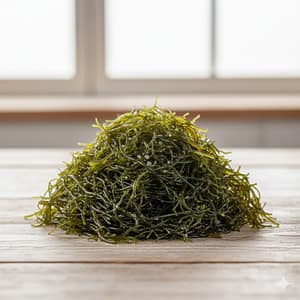- Home
- Mozuku Seaweed (Cladosiphon okamuranus)

I. General Information
A. Scientific Name:
Cladosiphon okamuranus
B. Alternative Names:
Mozuku, Okinawan seaweed
C. Pronunciation:
Moh-zoo-koo
II. Sourcing and Origin
A. Source:
Exclusively farmed in Okinawa, Japan, using rope and net aquaculture.
B. Geographic Origin:
Okinawa, Japan.
C. Method of Processing:
Harvested fresh, washed, and preserved in vinegar or saltwater.
III. Properties and Uses
A. Physical Properties:
Brown, string-like seaweed
Slippery texture
Mild flavor
B. Chemical Composition:
Fucoidan polysaccharides
Iodine, calcium, magnesium
Antioxidants
C. Primary Uses:
Skincare: Anti-aging extracts in serums.
Haircare: Nourishing minerals for scalp health.
Wellness: Supports immunity and longevity.
Culinary: Served with vinegar, soups, and salads.
Household: Traditional Okinawan preserved food.
D. Key Benefits:
Rich in fucoidan (linked to immune health)
Supports longevity and vitality
High mineral content
IV. Safety and Considerations
A. Potential Allergies:
May cause reactions in those sensitive to iodine.
B. Best Practices for Use:
Best eaten fresh with vinegar or in soups
C. Special Precautions:
Avoid overconsumption if iodine-sensitive.
V. Fun & Educational Facts
A. Historical Context:
Considered a superfood and a staple in the Okinawan diet, associated with long life expectancy.
B. Did You Know?
Mozuku is one of Okinawa’s top aquaculture products.
C. DIY Recipe Idea:
Mozuku vinegar salad
Miso soup with mozuku
Okinawan mozuku tempura
